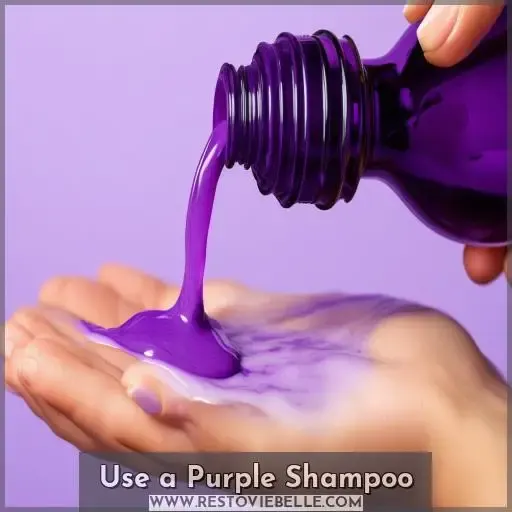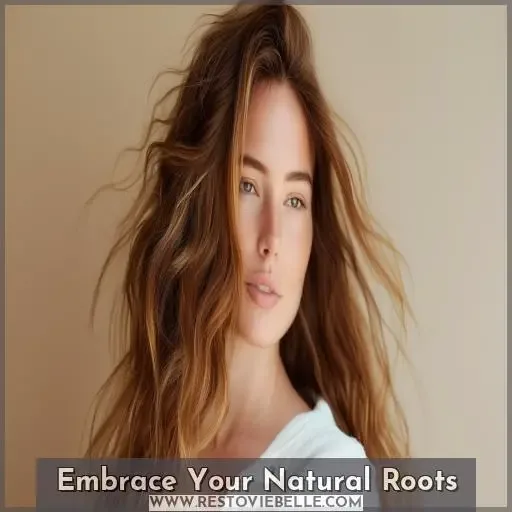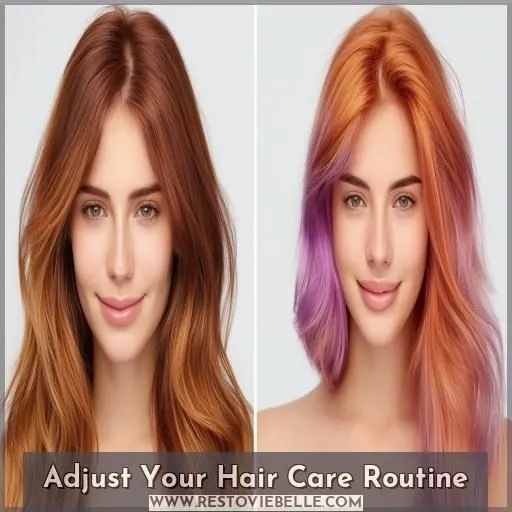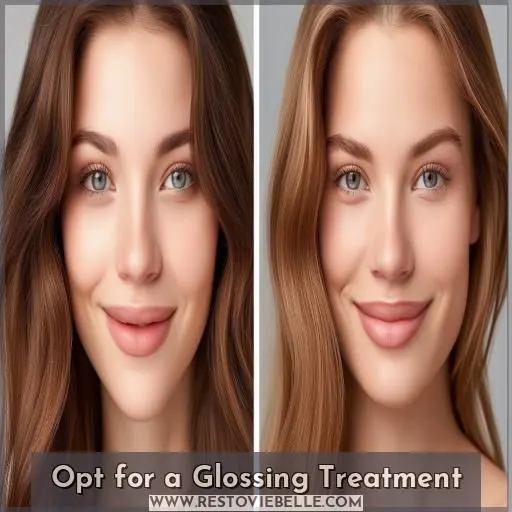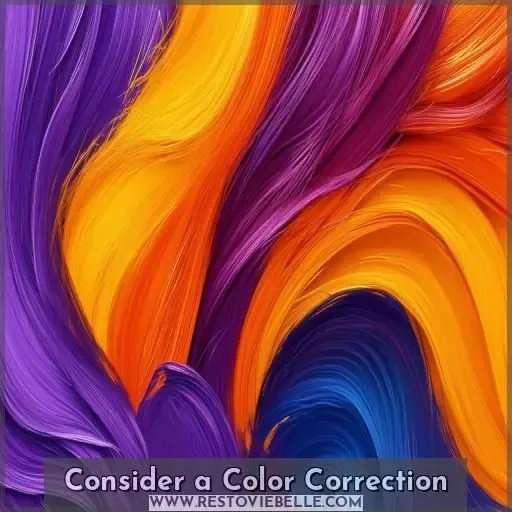This site is supported by our readers. We may earn a commission, at no cost to you, if you purchase through links.
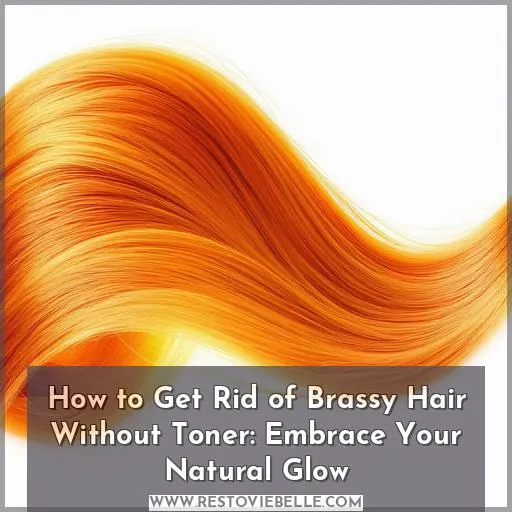 Battling brassy hair without toner? You’ve got options!
Battling brassy hair without toner? You’ve got options!
First, use a purple shampoo weekly to neutralize warmth.
Then, Embrace your natural roots by letting them grow out or getting blended highlights.
Adjust your routine with gentle, Sulfate-free products and limit heat styling.
For an extra boost, get a glossing treatment to enhance your hue and shine.
If all else fails, consult a professional for a color correction.
With the right approach, you’ll tame the brass and let your natural radiance shine through.
Want to learn more tips and tricks?
Table Of Contents
Key Takeaways
- Let’s be honest, brassy hair can be a real beast to tame – but don’t fret! With a little creativity and persistence, you can embrace your natural glow and kiss those pesky warm tones goodbye.
- Why fight nature when you can work with it? Letting your roots grow out or adding some blended highlights creates a seamless, dimensional look that says, "I woke up like this – and I’m owning it!"
- Pamper those locks with the right products. Sulfate-free shampoos and conditioners are like a soothing spa day for your strands, keeping them nourished and radiant. And who doesn’t love a little self-care?
- If all else fails, don’t be afraid to bring in the big guns – a professional color correction. Those hair wizards know their stuff, and they’ll have you rocking your dream shade in no time (with minimal damage, of course).
How to Get Rid of Brassy Hair Without Toner?
To get rid of brassy hair without using toner, you can use a purple shampoo regularly to neutralize unwanted warm tones, or embrace your natural roots as they grow out. Additionally, adjusting your hair care routine to include moisturizing products and limiting heat styling can help reduce brassiness.
Use a Purple Shampoo
To get the most out of a purple shampoo for brassy hair, use it once or twice a week, leaving it on for a few minutes before rinsing. Apply it evenly from roots to ends, focusing on the brassi-est areas, and work it through your hair with your fingertips.
Frequency of Use
You’ll want to use a purple shampoo once or twice weekly to counteract brassiness. Frequency depends on your hair’s porosity and how quickly it turns brassy. Start by applying it to damp hair, massaging it in, and letting it sit for 3-5 minutes before rinsing. Be patient—consistent use over several weeks delivers the best results.
Technique for Application
To effectively apply purple shampoo, follow these steps:
- Wet your hair thoroughly
- Dispense a quarter-sized amount of shampoo onto your palms
- Gently massage it into your hair, focusing on the brassiest areas
- Let it sit for 3-5 minutes to allow the pigments to work
- Rinse thoroughly with cool water
Using cool water helps seal the cuticle, locking in the toning effects. Be careful not to let the shampoo sit too long, as it can create an ashy cast.
Importance of Leaving It On
Leaving the purple shampoo on for 3-5 minutes is essential to avoiding damage and maintaining your color’s vibrancy. It allows the pigments to effectively neutralize brassy tones, enhancing shine and preserving your locks’ radiant glow. Embrace this small step as part of your haircare ritual – your strands will thank you with a vibrant, healthy hue.
Embrace Your Natural Roots
You can let your natural roots grow out, allowing your brassy tones to blend seamlessly with your new growth. Embracing a rooted look can create a unique, dimensional style that showcases your authentic hair color without the need for toning or coloring.
Letting Your Natural Color Grow Out
Instead of covering up your brassy hair, you can embrace your natural color by letting it grow out. This approach is perfect for those looking to gradually shift to their true shade.
Regularly oiling your hair and caring for your scalp** can help strengthen and nourish your roots as they grow in.
Deep conditioning treatments or homemade hair masks can also keep your natural outgrowth healthy and vibrant.
Blending Regrowth With Highlights
Consider getting root touch-ups or gradual blending highlights to create a seamless change from your brassy ends to natural roots. This provides:
- A natural dimension to your hair color
- A hassle-free grow-out process
- A low-maintenance, cost-effective solution
Root touch-ups and blending highlights can be done professionally or with home remedies for a refreshed, brassy-free look.
Embracing a Rooted Look
You can also embrace your natural roots and let your gray hair grow out for a trendy, rooted look. This low-maintenance option allows you to rock natural highlights while reducing damage from frequent coloring. Embrace the easy, carefree vibe of salt-and-pepper strands by styling your hair to blend the regrowth seamlessly.
Adjust Your Hair Care Routine
To start adjusting your hair care routine, skip shampoos and conditioners containing sulfates and harsh detergents, as these can strip your hair of its natural oils and leave it looking brassy. Instead, opt for gentle, moisturizing formulas that’ll help keep your strands nourished and vibrant.
Avoiding Sulfates and Harsh Detergents
You’ll want to avoid sulfates and harsh detergents, as these strip your hair’s natural oils, exacerbating brassiness. Instead, opt for:
- Clarifying shampoos that gently cleanse
- Color-depositing shampoos to counteract brassy tones
- Chelating shampoos that remove mineral buildup
- Vinegar rinses or DIY home remedies like chamomile tea
These gentle alternatives preserve your hair’s vibrant hues without stripping color.
Using a Moisturizing Conditioner
You’ll also want to incorporate a moisturizing conditioner into your routine. Look for deep conditioning treatments, hair masks, or leave-in products to help nourish and hydrate your strands. Here’s a handy guide:
| Product | Use | Benefits |
|---|---|---|
| Hair Mask | Weekly | Intense moisture |
| Leave-In Conditioner | Daily | Detangles & smooths |
| Hot Oil Treatment | Monthly | Restores shine & softness |
Regular conditioning is key to keeping brassiness at bay.
Limiting Heat Styling
You’ll also want to limit heat styling as much as possible.
Blow drying, straighteners, and curling irons can exacerbate brassiness.
Opt for air drying and protective styling instead.
When you do use hot tools, prep with a heat protectant and use the lowest effective temperature.
Embrace your natural texture – the less heat you apply, the richer and more vibrant your color will look.
Opt for a Glossing Treatment
A glossing treatment is a semi-permanent hair color service that can help tone down brassy, unwanted warm tones in your hair. It’s beneficial for brassy hair because it deposits glossy, cool-toned pigments to neutralize and enhance your hair’s natural hue without dramatically altering your base color.
What is a Glossing Treatment?
A glossing treatment is a color-depositing process that adds temporary tint while enhancing shine. It uses demi- or semi-permanent color mixed with a glossing solution to create a translucent, glossy finish. Unlike permanent color, a gloss is a non-damaging way to boost vibrancy and neutralize unwanted brassy tones. It’s an excellent option for reviving faded locks without commitment.
Benefits for Brassy Hair
A glossing treatment is an excellent solution for embracing your natural glow while reducing brassiness. It enhances color vibrancy, restores hair health, and adds lustrous shine – all without stripping or damaging your strands. By embracing this gentle, home remedy, you’ll love how your locks radiate warmth and depth from within.
How Often to Get a Gloss
You’ll want to get a gloss treatment every 4-6 weeks to maintain your radiant, brassiness-free locks. Consider:
- Salon glosses offer longer-lasting, professional results
- At-home glosses are a more budget-friendly, temporary fix
- Glossing frequency depends on your hair’s porosity and color treatment history
- Listen to your strands – they’ll let you know when it’s time for a refresher!
Consider a Color Correction
If your brassy hair is stubborn and other methods haven’t yielded the desired results, it may be time to seek professional help for a color correction. During this process, a skilled colorist will analyze your hair and apply the appropriate toners and glosses to neutralize unwanted brassy tones, leaving you with a vibrant, natural-looking shade.
When to Seek Professional Help
If your brassy hair persists despite at-home efforts, it’s time to seek professional help. Color fading or uneven root touch-ups can indicate a need for corrective action. Schedule a salon consultation; experts can assess your hair’s condition and recommend a corrective bleach or coloring process utilizing their professional expertise.
What to Expect During the Process
If you opt for a color correction, be ready for a chemical reaction that alters your hair’s porosity. The processing time depends on your hair type, with coarser textures needing longer. A professional colorist prioritizes damage prevention, ensuring your hair’s integrity remains intact. Embrace the transformation as unwanted brassy tones make way for your desired hue.
Maintaining Results After a Color Correction
After a color correction, you’ll want to maintain the results with regular root touch-ups and home care. Use sulfate-free, color-safe products to prevent fading, and limit heat styling. Consider gradually moving towards your natural shade with balayage highlights or an ombre effect for a seamless, low-maintenance look that embraces your roots.
Frequently Asked Questions (FAQs)
How long does the brassy hair tone last?
Your brassy tone will fade like fire’s embers – sun rays and washing may bleach it within 4-6 weeks. Maintain its vibrancy with toning glosses or purple-tinted shampoos. Regular trims also refresh your hue. With patience, that brassiness dissipates naturally.
Can hard water cause brassiness in hair?
Yes, hard water can cause brassiness in your hair. The minerals in hard water deposit on strands, giving blonde or gray hair an unwanted orange or yellow tint. Installing a water softener or using a chelating shampoo helps remove those minerals and prevent brassiness.
What are the risks of using purple shampoo?
In the quest for vibrant tresses, using purple shampoo carries risks like dryness, brittleness, and potential hair discoloration if overused. Moderation is key for a shampoo that could be a hair hue hero or heckler.
Do home remedies work for brassy hair removal?
Some natural remedies can help tame brassiness, like using chamomile tea or apple cider vinegar rinses. However, for best results, consult a professional colorist for a proper toning treatment.
How often should I get color correction treatments?
Over 60% of color-treated hair requires professional correction every 6-8 weeks. For vibrant, healthy locks, book regular appointments with a trusted stylist to keep brassy tones at bay.
Conclusion
Roughly 60% of women struggle with brassy tones in their hair. Ultimately, getting rid of brassy hair without toner involves a combination of strategic product use, embracing natural roots, and professional assistance when needed. By following these tips and consistently maintaining a gentle, color-preserving routine, you’ll successfully tame unwanted warm tones and let your natural, radiant hue shine through.

